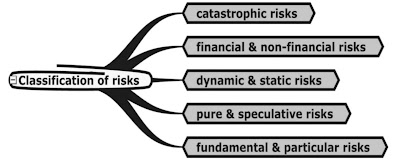Risks in insurance, classification of risks in insurance, types of risks in insurance, different types of risks in insurance
Risks in Insurance, Classification of Risks in Insurance, Types of Risks in Insurance
The chance of occurrence of unexpected loss or damage due to uncertain or unexpected peril is called risk in insurance.
Insurance covers only those risks where the possibility of occurrence is uncertain( not confirmed). If the possibility of the occurrence of the event is certain, then that risk will not be covered by the insurance company. For Example, a person who is suffering from cancer can not be covered by the insurance company normally.
Classification of Risks
Risks can be classified into five broad categories-
1- Catastrophic or Critical Risks
2- Financial and Non-Financial Risks
3- Dynamic and Static Risks
4- Pure and Speculative Risks
5- Fundamental and Particular Risks
1- Catastrophic or Critical Risks:- Critical or Catastrophic risks are defined as those risks where a single event of major magnitude leads to a significantly higher than usual number or amount of claims on an insurer are known as critical or catastrophic Risks.
Catastrophic risks are big enough to cause the bankruptcy of the owner or even the insurer.
2- Financial and Non-Financial Risks:-The risks in which the outcome of the event is measurable in terms of the money, i.e., any loss that could occur due to the risk can be measured by the concerned person in monetary value are known as financial risks. These risks are insurable. An example of financial risk includes a loss to the goods in the warehouse of a company due to a fire.
Those risks in which the outcome of the event is not measurable in terms of money, i.e., any loss that could occur due to the risk can not be measured by the concerned person in the monetary value are known as non-financial risks. Non-financial risks where the financial impact can not be estimated cannot be insured. An example of non-financial risk is the risk of poor selection of the brand while purchasing mobile phones.
3- Dynamic and Static Risks:-Those risks that arise when there are any changes in the economy are known as dynamic risks. These risks are generally not easy to predict. These changes might bring financial losses to the members of the economy. These risks are generally not easily insurable. An example of dynamic risk includes the changes in the income of the persons in an economy.
Those risks which remain constant over the period and are generally not affected by the business environment are known as static risks. These risks arise from human mistakes or actions of nature. These are generally easily insurable as they are easy to measure. An example of static risk includes the embezzlement of funds in a company by its employees.
4- Pure and Speculative Risks:-Those risks refers to the situation where it is certain that the outcome will lead to loss of the person only or maximum it could lead to the condition of the break-even to the person, but it can never cause profit to the person are known as pure risks.
An example of pure risk includes the possibility of damage to the house due to natural calamity. In case natural calamity occurs, it will damage the house of the person and its household items, or it will not affect the person's home and household items. Still, this natural calamity will not give any profit or gain to the person. So, this will fall under the pure risk, and these risks are insurable.
Those risks refers to the situation where the direction of the outcome is not specific, i.e., it could lead to a condition of loss, profit, or break-even are known as speculative risks. These risks are generally not insurable.
An example of speculative risk includes the purchase of the shares of a company by a person. Now, the prices of the shares can go in any direction, and a person can make either loss, profit, or no loss, no profit at the time of sale of those shares.
5- Fundamental and Particular Risks:- Those risks that affect a lot of people together are known as fundamental risks. For example, a train accident is a fundamental risk as it affects a lot of persons.
Those risks that affect only specific persons are known as particular risks. For Example, Theft in a particular house affects only the owner.
Also Read-

